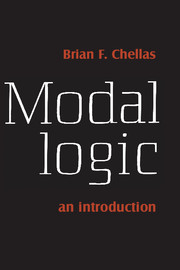3 - Standard models for modal logics
Published online by Cambridge University Press: 05 June 2012
Summary
According to the account of necessity and possibility in chapter 1, a sentence of the form □A is true at a possible world just in case A itself is true at all possible worlds, and a sentence of the form ◇A holds at a possible world if and only if A holds at some possible world. This idea was modeled very simply in terms of a collection of possible worlds together with an assignment of truth values, at each world, to the atomic sentences. We saw that the ensuing notion of validity is quite strict, encompassing as it does a large assortment of principles.
In the present chapter we modify this leibnizian conception of necessity and possibility by introducing an element of relative possibility. The result is a much more supple notion of validity, one that greatly reduces the stock of principles that are bound to hold.
In section 3.1 we define the idea of a standard model, state the truth conditions for modal sentences at worlds in models of this sort, and prove a theorem about validity in classes of standard models. In section 3.2 we single out the schemas D, T, B, 4, and 5 for special attention, both because of their historical prominence (recall that they are all theorems of S5) and because the techniques required for their treatment are illuminating and instructive.
- Type
- Chapter
- Information
- Modal LogicAn Introduction, pp. 67 - 112Publisher: Cambridge University PressPrint publication year: 1980



